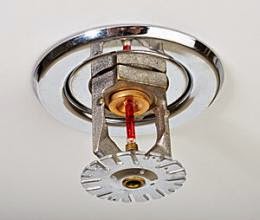When we think of fire protection services, we often think of the usual -- fire sprinklers, a bright, red fire extinguisher and loud fire bells. While these standards are still relevant, the year 2014 will see a welcoming of both technology and style into the industry. These trends will not only keep us safer but also fit seamlessly into our modern, chic homes. Below we examine three big trends that will be hitting the world of fire protections services. Read more about this new equipment to see if any may be a fit for you.

Fire Retardant Materials
Fire retardant materials are now more versatile than ever as manufacturers continue to improve the technology. Treating the items with a fire retardant chemical, many types of fabric can be used including cotton, silk, nylon, and even velvet. A popular consumer product that has been chemically treated for years is children’s pajama sets with treating on both the PJ tops and bottoms. These treated fabrics are extremely helpful in case of a fire as they will not ignite with flames. The fire retardant process can also be applied to existing materials throughout the home or workplace.
Voice Evacuation Systems
Voice evacuation systems are quickly becoming popular technology advancements in the fire protection services world. These units work much like a typical fire alarm system with the ability for the unit to detect smoke and temperature. Once activated, the voice will direct people on what to do and where to go. Many companies are also tying in varying languages and messages to meet the ever-changing demands. This feature has been further expanded with the integration of both music and instruments into the evacuation message.
Stainless Steel Fire Extinguishers
Stainless steel isn’t just for residential kitchen appliances anymore. This stylish metal is also great for equipment in the home built to put out fires such as fire extinguishers. Fire extinguisher manufacturers are taking note of this trend that has been around for years and is now here to stay. To address their customer’s desire for both form and function, the fire extinguisher industry has met the demand by incorporating this design feature into their units making them both beautiful and functional. Rather than having an eye sore sticking out with the typical red extinguisher, this steel model can fit anywhere and blend into its surroundings with ease.
If your home or business is already fully protected, you may not see a need to add any more fire protection services to your arsenal. But if you are lacking some needed protection try incorporating these three trends for 2014. The voice evacuation system would be an excellent safeguard for a large building or office complex. A stainless steel extinguisher would be a perfect fit for a kitchen blending in nicely with your stainless steel oven and refrigerator. Fire retardant materials can be outfitted pretty much anywhere you use fabric whether it is in the office furniture or on your living room drapes. Keeping you safe in 2014, these three fire protection services trends are here to stay.
Having specialized in the Fire Protection Services signs trade for over 25 years, USAFP now works tirelessly to promote affordable fire safety for home and for business.
Source: Click Here

Fire Retardant Materials
Fire retardant materials are now more versatile than ever as manufacturers continue to improve the technology. Treating the items with a fire retardant chemical, many types of fabric can be used including cotton, silk, nylon, and even velvet. A popular consumer product that has been chemically treated for years is children’s pajama sets with treating on both the PJ tops and bottoms. These treated fabrics are extremely helpful in case of a fire as they will not ignite with flames. The fire retardant process can also be applied to existing materials throughout the home or workplace.
Voice Evacuation Systems
Voice evacuation systems are quickly becoming popular technology advancements in the fire protection services world. These units work much like a typical fire alarm system with the ability for the unit to detect smoke and temperature. Once activated, the voice will direct people on what to do and where to go. Many companies are also tying in varying languages and messages to meet the ever-changing demands. This feature has been further expanded with the integration of both music and instruments into the evacuation message.
Stainless Steel Fire Extinguishers
Stainless steel isn’t just for residential kitchen appliances anymore. This stylish metal is also great for equipment in the home built to put out fires such as fire extinguishers. Fire extinguisher manufacturers are taking note of this trend that has been around for years and is now here to stay. To address their customer’s desire for both form and function, the fire extinguisher industry has met the demand by incorporating this design feature into their units making them both beautiful and functional. Rather than having an eye sore sticking out with the typical red extinguisher, this steel model can fit anywhere and blend into its surroundings with ease.
If your home or business is already fully protected, you may not see a need to add any more fire protection services to your arsenal. But if you are lacking some needed protection try incorporating these three trends for 2014. The voice evacuation system would be an excellent safeguard for a large building or office complex. A stainless steel extinguisher would be a perfect fit for a kitchen blending in nicely with your stainless steel oven and refrigerator. Fire retardant materials can be outfitted pretty much anywhere you use fabric whether it is in the office furniture or on your living room drapes. Keeping you safe in 2014, these three fire protection services trends are here to stay.
Having specialized in the Fire Protection Services signs trade for over 25 years, USAFP now works tirelessly to promote affordable fire safety for home and for business.
Source: Click Here








